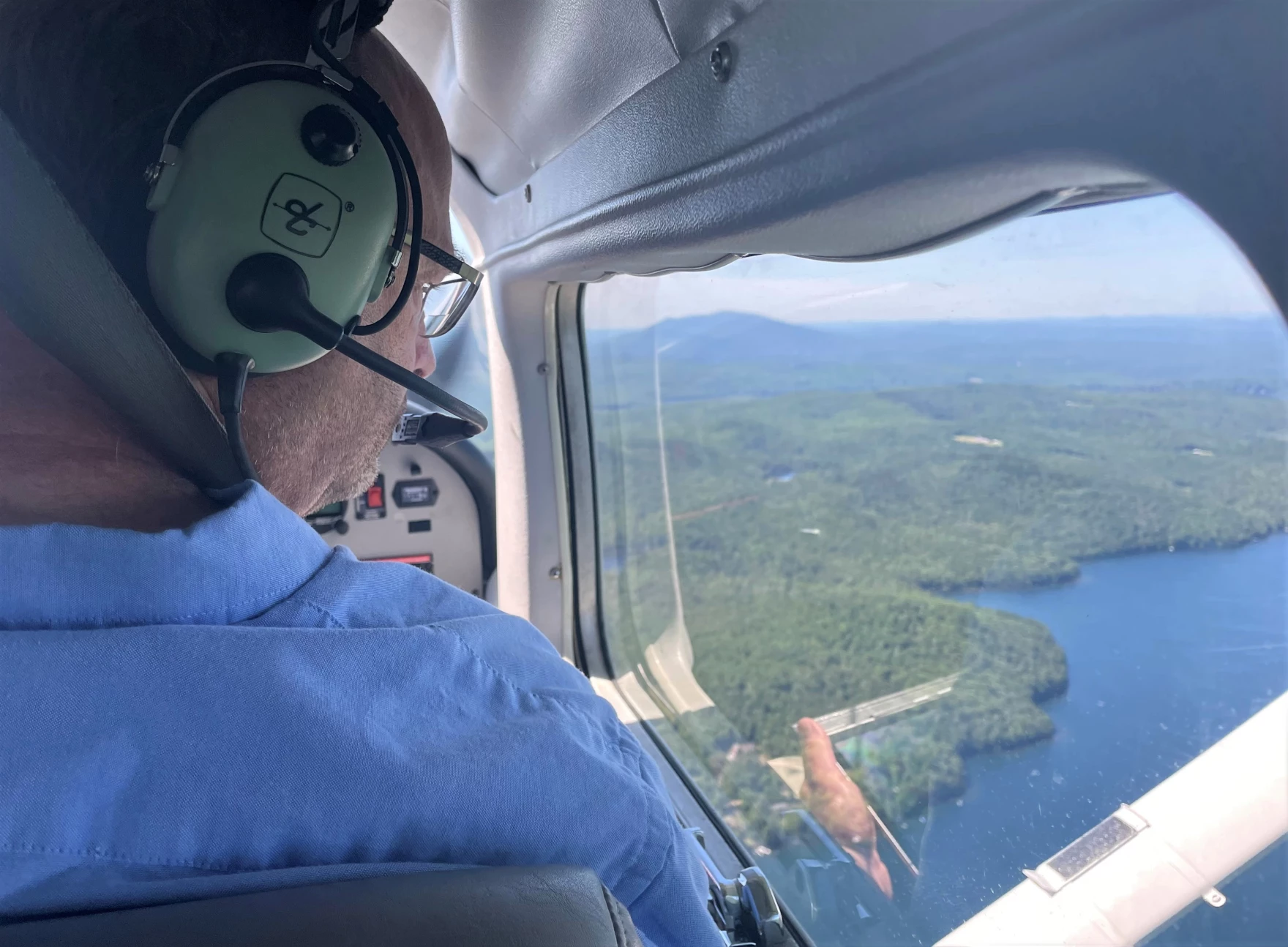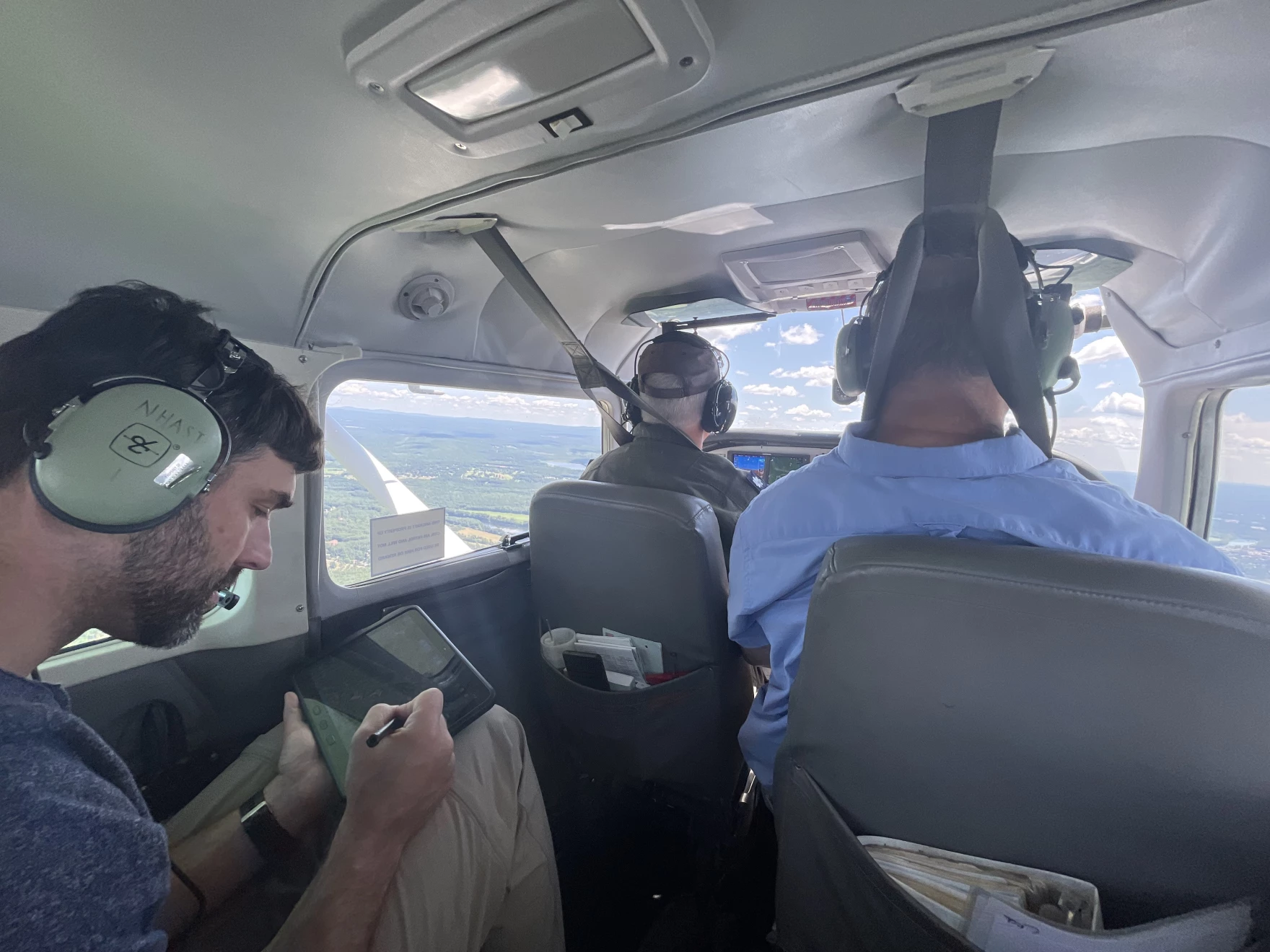Meet the foresters keeping an eye on New Hampshire’s trees from the sky

Forester Kyle Lombard looks out the window of the small airplane, searching for damage in the New Hampshire forest below. (Mara Hoplamazian / NHPR)
Most of the year, New Hampshire’s Forest Health team is on the ground, in the woods, doing what they can to protect the state’s trees. But for a few days every summer, they get to soar above it all.
Foresters Bill Davidson and Kyle Lombard make up the two-person operation affectionately known as the Bug Patrol. They make about five trips up in a tiny airplane each season to do an aerial survey of the state’s forests, looking for sick trees – often harmed by insects.
On a warm morning in July, the team meets at Concord’s municipal airport for a short planning session with Civil Air Patrol pilot Ken Peperissa, who will helm the Cessna 206 for the day.
Together, they map out the flight path – careful parallel lines, spaced four miles apart, up and down a stretch of southwestern New Hampshire. Throughout the summer, they’ll survey about 4 million acres of forest, everything except for federal lands.
There’s not much elbow room in the little plane – its cabin is about the size of a Mini Cooper. No tiny cups of Ginger Ale, no lavatories, no in-flight movie selection. Not even a “fasten seatbelt” sign. Nonetheless, the team buckles up, and Peperissa begins his taxi.

Ken Peperissa is a Civil Air Patrol pilot. (Mara Hoplamazian / NHPR)
With the green light from Air Traffic Control, we take off. After a few minutes the city fades, the golden dome of the State House and the Market Basket parking lots fall away. From the air, it’s hard to tell there’s anything besides trees. The view from above feels unique, Lombard says.
“You can really see why New Hampshire is the second-most forested state in the country,” he says. “If it’s not paved, it’s got trees on it.”
Once the plane levels off, it’s time to get to work. Lombard looks out over the right wing of the plane, and Davidson looks left, searching for missing leaves, brown patches, anything that looks amiss.
Davidson spots the traces of Spongy Moth caterpillars, which have been eating the state’s oak trees.
“You can see there’s patches of that brown scattered all across the landscape. Pretty much all the oaks in this area have been defoliated,” he says. “Wherever they are, the caterpillars find them and eat them.”
Spongy Moths stripped 50,000 acres last summer, and they’re at it again this year.
“You can really see why New Hampshire is the second-most forested state in the country.”
Another bug Davidson has his eyes out for is the Emerald Ash Borer. He’s seeing lots of that damage on today’s flight.
“The trees that are infested with Emerald Ash Borer die quickly, and so you’ll have dead ash trees scattered across the landscape. And those appear as kind of skeletons of trees scattered throughout the forest,” he says.
The two foresters sketch out all the damage they see on a pair of rectangular touch screens that kind of look like iPads. A small emoji airplane moves across a digital map of the forest as we fly, like inflight Google Maps.

Davidson and Lombard record the shape of the damage they see from the airplane on digital tablets. (Mara Hoplamazian / NHPR)
Using a stylus, they outline areas of injured trees, and mark down what caused the issue. Despite the team’s nickname, they say it’s not just bug damage they’re looking for.
On one trip, Davisdson says they mapped some discoloration in the forest from the air, then went to check it out on the ground, only to find that the culprit was domestic pigs.
The pigs only got to about five acres of forest. But some of the damage Lombard has seen in his 28 years was much larger. The worst, he says, was from an ice storm in 1998.
“I don’t think it could ever be rivaled. The amount of damage that ice storm did was in the hundreds of thousands of acres. And it literally just broke trees, just snapped right in half,” he says.
Back then, Lombard says, his team’s technology looked a lot different. They did their work with laminated maps and colored pens. Soon, it could be drones and satellites, instead of humans in airplanes.
And not everybody would miss it. As we fly by Mount Monadnock, the cabin starts to shake and dip with turbulence. By hour three, the tiny plane is uncomfortable – hot and sort of claustrophobic.
It’s easy to feel a little green.
“I’m at least normally some degree of nauseous, ranging from slightly to heavily,” Davidson said.
Lombard says the nausea and headache that come with tiny airplane trips get to him, too. But despite the discomfort, Lombard says, he’d miss the flights – especially the unique aerial perspective.
“I’m in meetings all the time. And people are always worried about this, that, and the other thing with the forest. And it’s like, wow, you need to take a little small airplane ride. And just so you get some perspective on how much forest there is and how green it is and just how much forest ecosystem we have to manage,” he says.
